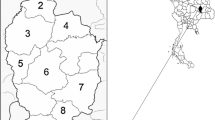Abstract
A total of 123 avian faecal specimens randomly collected in Bohemian commercial aviaries, Zoo parks and countryside were screened for the presence of human pathogenic microsporidia by both calcofluor M2R staining and polymerase chain reaction. Of these, no positive sample was detected using microscopical examination, and one isolate was detected by polymerase chain reaction and identified as Encephalitozoon cuniculi. Cockateel (Nymphicus hollandicus) represents a new avian host of this microsporidian.

Similar content being viewed by others
References
Barton CS, Phalen DN, Snowden KF (2003) Prevalence of microsporidian spores shed by asymptomatic lovebirds: evidence for a potential emerging zoonosis. J Avian Med Surg 17:197–202
Black SS, Steinohrt LA, Bertucci DC, Rogers LB, Didier ES (1997) Encephalitozoon hellem. in budgerigars (Melopsittacus undulatus). Vet Pathol 34:189–198
Branstetter DG, Knipe SM (1982) Microsporidian infection in the lovebird Agapornis roseicollis. Micron 13:61–62
Canny CJ, Ward DA, Patton S, Orozs SE (1999) Microsporidian keratoconjunctivitis in a double yellow-headed amazon parrot (Amazona ochrocephala oratrix). J Avian Med Surg 13:279–286
Carlisle MS, Snowden K, Gill J, Jones M, O’Donoghue P, Prociv P (2002) Microsporidiosis in a gouldian finch (Erythrura [Chloebia] gouldiae). Aust Vet J 80:41–44
Daft BM, Kinde H (1989) Microsporidiosis in nestling budgerigars (Melopsittacus undulatus). Proceedings of the 38th Western poultry disease conference. California, USA, pp 157–159
Didier ES (2005) Microsporidiosis: an emerging and opportunistic infection in humans and animals. Acta Trop 94:61–76
Didier ES, Didier PJ, Friedberg DN, Stenson SM, Orenstein JM, Yee RW, Tio FO, Davis RM, Vossbrinck C, Millichamp N et al (1991) Isolation and characterisation of a new human microsporidian, Encephalitozoon hellem (n. sp.), from three AIDS patients with keratoconjunctivitis. J Infect Dis 163:617–621
Didier ES, Snowden KA, Shadduck JA (1998) The biology of microsporidian species infecting mammals. Adv Parasitol 40:279–316
Gelis S, Raidal SR (2006) Microsporidiosis in a flock of tricolor parrot finches (Erythrura tricolor). Vet Clin North Am Exot Anim Pract 9:481–486
Gray ML, Puette M, Latimer KS (1998) Microsporidiosis in a young ostrich (Struthio camelus). Avian Dis 42:832–836
Haro M, Izquierdo F, Henriques-Gil N, Andrés I, Alonso F, Fenoy S, del Águila C (2005) First detection and genotyping of human-associated microsporidia in pigeons from urban parks. Appl Environ Microbiol 71:3153–3157
Kahler AM, Thurston-Enriquez JA (2007) Human pathogenic microsporidia detection in agricultural samples: method development and assessment. Parasitol Res 100:529–538
Katzwinkel-Wladarsch S, Lieb M, Heise W, Lecher T, Rinder H (1996) Direct amplification and species determination of microsporidian DNA from stool specimens. Trop Med Int Health 1:373–378
Keeling PJ, Fast NM (2002) Microsporidia: biology and evolution of highly reduced intracellular parasites. Ann Rev Microbiol 56:93–116
Kemp RL, Kluge JP (1975) Encephalitozoon sp. in the blue-masked lovebird, Agapornis personata (Reichenow): first confirmed report of microsporidian infection in birds. J Protozool 22:489–491
Lobo ML, Xiao L, Cama V, Magalhaes N, Antunes F, Matos O (2006) Identification of potentially human-pathogenic Enterocytozoon bieneusi genotypes in various birds. Appl Environ Microbiol 72:7380–7382
Lowenstine LJ, Petrak ML (1980) Microsporidiosis in two peach-faced lovebirds. In: Montali RJ, Migaki G (eds) The comparative pathology of zoo animals. Smithsonian Institution, Washington, DC, pp 365–368
Norton JH, Prior HC (1994) Microsporidiosis in a peach-faced lovebird (Agapornis roseicollis). Aust Vet J 71:23–24
Novilla MN, Kwapien RP (1978) Mirosporidian infection in the pied peach-faced lovebird (Agapornis roseicollis). Avian Dis 22:198–204
Phalen DN, Logan KS, Snowden KF (2006) Encephalitozoon hellem. infection as the cause of a unilateral chronic keratoconjunctivitis in an umbrella cockatoo (Cacatua alba). Vet Ophthalmol 9:59–63
Poonacha KB, William PD, Stamper RD (1985) Encephalitozoonosis in a parrot. J Am Vet Med Assoc 186:700–702
Powell S, Tang K, Chandler F (1989) Microsporidiosis in a lovebird. J Vet Diagn Invest 1:69–71
Pulparampil N, Graham D, Phalen D, Snowden K (1998) Encephalitozoon hellem. in two eclectus parrots (Eclectus roratus): identification from archival tissues. J Eukaryot Microbiol 45:651–655
Randall CJ, Lees S, Higgins RJ, Harcourt-Brown NH (1986) Microsporidian infection in lovebirds (Agapornis spp.). Avian Pathol 15:223–231
Reetz J (1993) Naturally-acquired microsporidia (Encephalitozoon cuniculi) infections in hens. Tierarztl Prax 21:429–435
Reetz J (1999) Natural transmission of microsporidia (Encephalitozoon cuniculi) by way of the chicken egg. Tierarztl Prax 22:147–150
Reetz J, Rinder H, Thomschke A, Manke H, Schwebs M, Bruderek A (2002) First detection of the microsporidium Enterocytozoon bieneusi in non-mammalian hosts (chickens). Int J Parasitol 32:785–787
Slodkowicz-Kowalska A, Graczyk TK, Tamang L, Jedrzejewski S, Nowosad A, Zduniak P, Solarczyk P, Girouard AS, Majewska AC (2006) Microsporidian species known to infect humans are present in aquatic birds: implications for transmission via water? Appl Environ Microbiol 72:4540–4544
Snowden K, Daft B, Nordhausen RW (2001) Morphological and molecular characterization of Encephalitozoon hellem in hummingbirds. Avian Pathol 30:251–255
Snowden K, Logan K (1999) Molecular identification of Encephalitozoon hellem in an ostrich. Avian Dis 43:779–782
Snowden K, Logan K, Phalen DN (2000) Isolation and characterization of an avian isolate of Encephalitozoon hellem. Parasitology 121:9–14
Suter C, Mathis A, Hoop R, Deplazes P (1998) Encephalitozoon hellem. infection in a yellow-streaked lory (Chalcopsitta scintillata) imported from Indonesia. Vet Rec 143:694–695
Thurston-Enriquez JA, Watt P, Dowd SE, Enriquez R, Pepper IL, Gerba CHP (2002) Detection of protozoan parasites and microsporidia in irrigation waters used for crop production. J Food Prot 65:378–382
Tocidlowski ME, Cornish TE, Loomis MR, Stoskopf MK (1997) Mortality in captive wild-caught horned puffin chicks (Fratercula corniculata). J Zoo Wildl Med 28:298–306
Vávra J, Chalupský J (1982) Fluorescence staining of microsporidian spores with the brightener “Calcofluor White M2R”. J Protozool 29:503
Weber R, Bryan RT, Schwartz DA, Owen RL (1994) Human micropsoridial infections. Clin Microbiol 7:426–461
Acknowledgements
This work was supported by the grant of the Grant Agency of the Czech Republic project no. 524/05/0992 and project no. 523/07/P117 and by a research project of the Institute of Parasitology, BC ASCR, v.v.i. (Z60220518).
Author information
Authors and Affiliations
Corresponding author
Rights and permissions
About this article
Cite this article
Kašičková, D., Sak, B., Kváč, M. et al. Detection of Encephalitozoon cuniculi in a new host—cockateel (Nymphicus hollandicus) using molecular methods. Parasitol Res 101, 1685–1688 (2007). https://doi.org/10.1007/s00436-007-0720-7
Received:
Accepted:
Published:
Issue Date:
DOI: https://doi.org/10.1007/s00436-007-0720-7




